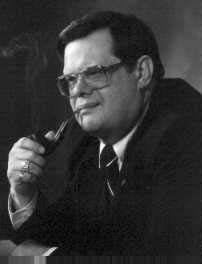 Jim
Tresner, 33
Jim
Tresner, 33
Book Reviews Editor for the Scottish Rite Journal
 Jim
Tresner, 33
Jim
Tresner, 33
Book Reviews Editor for the Scottish Rite Journal
Editor’s Note:
Publication information has been carefully checked
but is subject to change. Before ordering, we recommend you contact the
publisher.
 This
month, we take a look at some novels and stories in which Freemasonry plays
a part. These are not books about Freemasonry, but rather books in which
the Fraternity appears, not always clearly identified as such, but obvious
to the Mason.
This
month, we take a look at some novels and stories in which Freemasonry plays
a part. These are not books about Freemasonry, but rather books in which
the Fraternity appears, not always clearly identified as such, but obvious
to the Mason.
Three well-known classics, of course, are Brother Rudyard Kipling’s Kim and The Man Who Would Be King as well as the short story “The Inexperienced Ghost” by H. G. Wells. All should be easily available at your local library or any bookstore, and an excellent videotape of the film version of The Man Who Would Be King is easily available in most video rental outlets.
In passing, let me call your attention again to a book recently reviewed (the September 1996 Scottish Rite Journal) by Dr. S. Brent Morris, 33: Two Crowns for America by Katherine Kurtz (hardbound, 376 pages, Bantam Books, 1540 Broadway, New York, New York 10036). The book is “Dedicated to the Brotherhood of Freemasonry, under the All-Seeing Eye, whose Brethren helped shape America’s destiny, present at the creation.”
It is a fantasy of the ways in which Masonry, under the
guidance of the Comte de Saint-Germain (one of the more interesting figures
of legend), helped to win America’s independence and establish a new type
of government. It’s important to remember that it is a fantasy-it probably
didn’t happen this way. But a large part of me would like to believe it
could have.
Robert Heinlein, so far as I can discover, was not a Mason. That’s hard to understand, because Masonry plays so important a part in many of his books, and it is obvious he has conceived a good opinion of the Craft. With over 20 million copies of his books in print, Heinlein is also one of America’s most popular authors. I’ve read almost everything he wrote, but this one book stands out for sheer terror.
The story is set in the year 2100. Our hero is part of the elite guard of the Prophet, spokesman for a religious despotism which has overtaken the world. Slowly, he begins to understand the horror and repression of the religious government, and finally joins a group known as the cabal, a secret band dedicated to the overthrow of the religious dictatorship and the establishment of liberty. What is the cabal? Our hero recounts his experience in joining it.
“. . .I heard a strong bass voice intoning a prayer:
‘Vouchsafe thine aid, Almighty Father of the Universe...
love relief and truth to the honor of Thy Holy Name. Amen.’
And the answering chorus, ‘So mote it be!’
Then I was conducted around the room, still hoodwinked,
while questions were again put to me. They were symbolic in nature and
were answered for me by my guide.”
Astonishingly, the book was written in 1939. Today, with the growth of the so-called “Christian Reconstruction” movement with its announced goal of taking over government and with the inroads of the religious radical right into politics and local government, Revolt in 2100 is a book every Mason should read and ponder deeply.
In addition to which, it’s a whacking good adventure story.
For a completely different future sci-fi story about Masonry, The Artifact is hard to beat. The artifact itself is a enigmatic machine built aeons ago by another race. Since then, it has given ultimate power to, and then destroyed, every race with which it has come in contact. And now it has been found by humans. Where shall humanity, on the brink of interplanetary war with itself, find a person of absolute honor and integrity to deal with the artifact? In the Brotherhood, of course.
In the future, Masonry has become the guardian of advanced technology as well as lofty ideology, and it is almost the only force trying to prevent a bloody war. Not that Gear ever says that the Brotherhood is Masonry-but our hero’s first name is Solomon, his ship is the Boaz, he is assigned the task by the Grand Master who is, in turn, watched over by the Jurisprudence Committee. And there’s this example of dialogue:
All right, Speaker, Boaz is yours if you have the Word
and the Signs.
I have the word.
How do you have it?
I’ll letter and halve it with you.
Letter it and begin.
Begin you.
The Word is yours, you must begin.
The book can be read as an allegory of Masonic virtue,
but symbolism does not overcome lively narration. It’s a book of intertwined
plots and sharply drawn characters with plenty of action. You don’t need
to know a thing about Masonry to enjoy this book, but even a Mason who
never returned to Lodge after the Master Mason Degree will find the novel’s
Masonic ties rich and rewarding.
Granted Masons are supposed to be peaceable, law-abiding citizens-but what do you do when there is neither law nor peace? At times in the early American West, both were in short supply. Dempsey’s book is a historical novel, meticulously researched, which tells the story of early Montana and the Masons of the Bannack mining camp. The citizens of Bannack hired Henry Plummer as sheriff, little knowing that Plummer was, himself, the head of the outlaw gang which was terrorizing the community. Finally, when all else had failed, the Masons formed a Committee of Vigilance (vigilantes) and straightened things out themselves.
The events, locations, times, and people in the book are
true and accurate. Read as a novel or as history-the book is valuable either
way.
Again, here is a highly recommended historical novel; and, again, it has more history than fiction. Brother Edwards, writing under the name Doby, tells this powerful story of an Irish family which comes to America during the Irish famine of the 1800’s.
The story opens as John Edwards, a Union Captain in the Civil War, is slowly dying of his wounds in a tent hospital, attended primarily by a wounded rebel soldier. Both are Masons, and their fraternalism quickly overcomes any enmity.
The story is true, based on letters John Edwards wrote
before and during his last days. Those letters and other family documents
(John Edwards was the author’s great-grandfather’s brother) paint a compelling
portrait of life in Ireland during the famine, of the Irish slums in New
York in the mid 1800s, and of the family’s successful move to create a
farm in Michigan. Lodge records and battlefield accounts trace Edwards’s
career in the Civil War, giving a uniquely human and individual perspective
both to the ravages of nature and the conflicts of nations. It’s a fine
read and, like the other books reviewed in this column, worthy of any Mason’s
library.
Visitors Welcome
It is always a pleasure to welcome visitors to the House
of the Temple, 1733 Sixteenth Street, NW, Washington, DC 20009-3103. Located
on Sixteenth Street between R and S Streets, seven blocks NE of the Dupont
Circle Metro stop, Red Line, the Temple is open to Brothers, guests, and
the general public for tours from 8 am to 2 pm on weekdays. The Temple
is also open on weekends and holidays for groups of 25 or more provided
special arrangements are made in advance with the Grand Executive Director's
office (202)232-3579. Visitors are requested to register at the door.